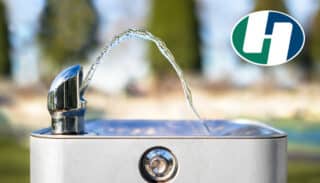STAYING HYDRATED IN THE WARM WEATHER
With the warm weather approaching, it is imperative to stay hydrated. The dog days of summer have hit with temps 100 degrees and higher! Not only is this unpleasant, it can be dangerous. Our body’s fluid requirement increases as the temperature rises and being dehydrated can have serious effects on your health. Check out my tips on how to keep yourself hydrated and learn which foods/beverages hydrate you.
Functions of fluid in the body
Our body is made up of 55 – 60% water. Water is essential for life and plays vital roles in the body, including regulation of metabolism and body temperature. Every day we lose water about 2 1/2 liters of water through breathing, perspiration, urine and bowel movements. And when you are outside in the heat, you lose even more. For our bodies to function properly, we need to replenish these fluid losses by consuming beverages and foods that contain water.
Who is at risk for dehydration?
Everyone who goes outside in the heat is at risk for dehydration, but those people who work or exercise outdoors, children, the elderly and anyone who has a pre-existing conditions—such as respiratory or cardiovascular related conditions, or diabetes has a greater risk.
Symptoms of dehydration
Symptoms of dehydration range from mild to life threatening. How many times have you had a headache, a dry mouth, felt weak or haven’t urinated in hours? It’s possible that you were dehydrated. Other symptoms include constipation, dry eyes, muscle cramps, decreased sweating, and nausea. While not a symptom, dehydration can increase risk of kidney stones. More serious symptoms include mental confusion, vomiting, racing pulse, difficulty breathing, seizures, etc. At this point, medical attention is needed immediately.
How much fluid do you need a day?
The recommendation used to be that we consume 64 oz of water a day. However newer research led to updated recommendations by the Institute of Medicine:
– adequate intake for men is ~ 3 liters (about 13 cups) of total beverages a day
– adequate intake for women is ~ 2.2 liters (about 9 cups) of total beverages a day.
It has also been shown that we can meet up to 25% of our fluid needs from watery foods, such as tomatoes, lettuce, watermelon and oranges. (check out this chart for more info – remember to divide by 28 to convert grams to ounces!)
*Keep in mind that your fluid needs will be higher if you work or exercise in the heat!
Tips to increase your fluid intake in the hot weather
1. Eat watery fruits and veggies to get nutrition and fluid.
- Don’t wait until you are thirsty. By the time thirst sets in, you are already dehydrated.
- If you know you’ll be doing errands or in the car for extended periods of time, freeze bottles of water and take them with you. Drinking warm water when it is 90 degrees outside is not pleasurable! (nor is drinking hot Gatorade on a 60 mile bike ride!)
- At work, set concrete goals with regards to fluid intake, otherwise you may get caught up in what you are doing and forget to drink. For example, tell yourself that you need to finish at least 3 16 oz bottles of water by the end of the day.
- Drink 8 oz of water before you leave the house in the morning. Drink 8 oz with both lunch and dinner. Now you’ve consumed 24 ounces!
- While water is always best, other beverages such as tea and coffee (both iced and regular), juice, sports drinks and milk count as fluid. In the past it was said that caffeinated beverages dehydrated you. We now know that they can provide your body with fluid – if you are used to drinking them. My disclaimers:
*While I strongly discourage drinking soda, both regular or diet (for many reasons!), it does contain fluid and therefore will hydrate you. But try to get more of your fluid intake from water …
* But keep in mind that sports drinks and juices tend to contain large amounts of sugar – not a good thing for most of us …
* While caffeinated beverages can provide fluid, I don’t recommend consuming large amounts of caffeine (and some people shouldn’t consume any). See my previous post on caffeine …
- If you don’t love plain water, try adding a squeeze of lemon or lime to flavor it. Or drink flavored seltzer.
- If you are exercising for 60 minutes+ (especially if it is in the heat), drink a sports drink that contains electrolytes and carbohydrates. Otherwise, plain water is fine. If you are working in the heat and sweating profusely, you may want to drink a low calorie sports drink such as G2 to get the electrolytes but with less sugar.
- A good way to test your hydration status is to check the color of your urine. Clear or light-colored urine means you’re well hydrated, whereas a dark yellow or amber color usually signals dehydration. Keep in mind that taking B vitamins can cause your urine to appear more yellow!
- It is highly unlikely that the average person will drink too much water. The exception may be with endurance athletes who drink large amounts of water when exercising for long periods of time. This can cause a potentially dangerous condition called hyponatremia (low sodium levels in the blood). This can be prevented by drinking a sports beverage that contains electrolytes (including sodium)
- Lastly – sorry but alcohol doesn’t count as fluid (to all my friends who get out the lemonade and vodka as soon as the temps rise … you know who you are!) Alcohol does the opposite and causes dehydration.
Be safe and drink up!
Written by Steve Rapoport of Fresh2o





